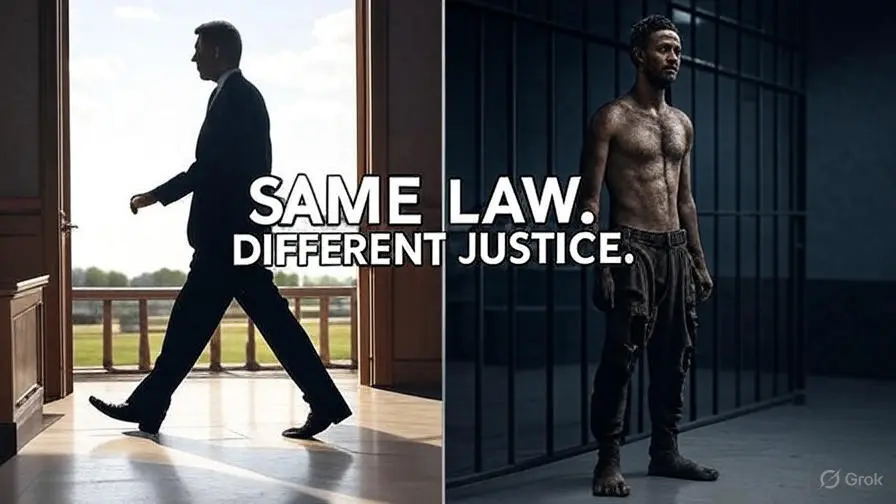LET’S NOT PRETEND IT’S EQUAL
When a billionaire launders money, he’s called a “businessman under investigation.” When a migrant steals ₹500, he’s branded a criminal, thrown into jail — no debate.
This isn’t just about crime. It’s about how the system protects suits and punishes sweat.
WHAT IS WHITE COLLAR CRIME?
Coined by Edwin Sutherland in 1939. He said — “White-collar crimes are committed by persons of respectability and high social status in the course of their occupation.”
Translation?
People in power use the system to rob without getting their hands dirty.
These crimes are non-violent. But don’t confuse that with harmless. They destroy trust. They rip through savings. They cripple entire economies. When a bank is looted from the inside, it’s not just a financial fraud — it’s the collapse of public faith.
Common White Collar Crimes in India:
- Corporate fraud – Fake profits, shell companies, siphoning money out while employees are left unpaid. Balance sheets become fiction. And investors? They lose everything.
- Tax evasion – Dodging taxes while preaching patriotism on TV. Lavish lifestyles on paper-thin ethics. This isn’t clever accounting — it’s calculated theft.
- Bank fraud – Using fake guarantees to get loans and then fleeing the country. The rich get loans on word. The poor can’t get one even with collateral.
- Insider trading – Leaking company info to manipulate markets. Profit for one, loss for thousands. One phone call, and a family’s investment is wiped out.
- Bribery & Corruption – Government contracts sold to the highest bidder, not the most deserving. Merit doesn’t matter when money talks louder.
- Money laundering – Turning black money white through real estate, fake businesses, offshore accounts. While the system looks the other way.
Laws that apply:
- IPC Sections: 409 (criminal breach of trust), 420 (cheating), 477A (falsifying accounts)
- Prevention of Corruption Act
- Companies Act
- Income Tax Act
- FEMA, PMLA, SEBI Act
But let’s not act like the law bites hard here. These laws exist on paper. In reality? The rich lawyer up, delay the process, settle out of court, or simply vanish. Trial drags for years. Evidence goes missing. Witnesses go silent. And the accused? They host parties. The justice system is a game, and they know how to play it.
WHAT IS BLUE COLLAR CRIME?
Now step into the world of the working class. No spreadsheets. No boardrooms. Just raw survival.
Blue collar crimes are committed by those who don’t have corporate shields. No family name to protect them. No access to legal strategy.
These crimes are visible. Immediate. Sometimes brutal. But often born out of desperation, not greed.
Common Blue Collar Crimes:
- Theft / Burglary – Breaking in to feed a family, not fund a foreign vacation. A stolen phone, a lifted wallet. Crimes of need, not luxury.
- Assault / Bodily harm – Street fights, domestic disputes, heat-of-the-moment violence. No calculated plan. Just impulse and anger.
- Robbery – Snatching a chain to pay rent. The act is wrong, but the reason is often survival.
- Vandalism – Protest turning into rage. Frustration painted on public walls and broken windows.
- Drug possession – Not the cartel kingpin, but the kid carrying a few grams. Often a victim of addiction, not a kingpin.
- Prostitution-related arrests – Always the sex worker, never the trafficker or the client. The system targets the vulnerable.
Laws that apply:
- IPC Sections: 323 (hurt), 379 (theft), 392 (robbery), 307 (attempt to murder)
- NDPS Act
- Immoral Traffic Prevention Act
- Arms Act
This side of the law moves fast. Arrest is immediate. Bail is a luxury. Trials are quick, brutal, and often careless. Legal aid is barely functioning. The poor get punishment. The system gets closure. Justice becomes speed, not fairness.
THE BIGGER ISSUE: SYSTEMIC BIAS
In Law, They’re Equal. In Practice, They’re Not.
| Point of Comparison | White Collar Crime | Blue Collar Crime |
|---|---|---|
| Visibility | Hidden in spreadsheets | Out in the open |
| Intent | Planned and calculated | Often impulsive or circumstantial |
| Damage | Mass financial loss | Individual or local impact |
| Media Coverage | Sanitised, respectful | Sensationalised, humiliating |
| Police Treatment | Delayed, hesitant | Immediate, aggressive |
| Legal Outcome | Bail, long trials | Quick jail time |
| Punishment | Negotiated | Non-negotiable |
The table says it. But the street screams it louder. The difference in treatment isn’t just about class. It’s about who the system is designed to protect. Who the system fears. Who it feels comfortable punishing.
REAL LIFE EXAMPLES
WHITE COLLAR:
- Nirav Modi: ₹11,400 crore PNB scam. Escaped. Still fighting extradition. Lived in luxury while the bank wrote off the loss.
- Vijay Mallya: ₹9,000+ crore loan default. Called a fugitive now. He was called “King of Good Times” before. Still attends court via video call.
- Satyam Scam: ₹7,000 crore cooked accounts. Thousands of jobs lost. One man took the fall. The system moved on like nothing happened.
- Saradha Scam: Chit fund scam. Poor investors are left devastated. Politicians shrugged. Justice delayed until memory faded.
BLUE COLLAR:
- A woman was jailed 8 months for alleged theft. The trial said not guilty. Who returns her time? Her life moved on, but her reputation didn’t.
- A Dalit boy was beaten for a bicycle he didn’t steal. The police apology came. But after the damage. After the trauma.
- A worker was caught with 200 grams of cannabis. 3-year sentence. No legal help. No rehab, no support. Just jail.
WHY THIS DOUBLE STANDARD EXISTS
Privilege buys protection. Period. The man who knows a minister walks free. The man who can’t afford a lawyer doesn’t even get to speak.
Police aren’t always corrupt. But they’re pressured. Crack a petty crime, show results. Big fish? Wait for orders.
Society judges differently. Greed in a suit is ambition. Need in torn clothes is criminal.
And let’s not ignore this: blue collar crimes are easy to solve. Physical evidence. CCTV. A stolen phone. White collar? You’re chasing digital trails, fake accounts, and layers of lies. Much harder. Much riskier. So it’s ignored or delayed. The system favors the path of least resistance.
THE BIGGER QUESTION
WHY DOES THE SYSTEM GO EASY ON THOSE WHO HURT MANY — AND HARD ON THOSE WHO HURT ONE?
Because we’ve built a legal machine that fears influence more than it fears injustice. We tiptoe around power, but we bulldoze the powerless. And every time we do, we tell the country: it’s not about what you did. It’s about who you are. Justice bends for pedigree. Not principal.
FAQs
Are white collar crimes less serious?
No. In fact, they often hurt more people. One fraud can destroy thousands of lives. But you wouldn’t know it from the way courts treat them. They’re seen as paperwork errors instead of what they really are: economic assaults.
Can blue-collar crimes be justified?
Legally, no. But morally? Sometimes. Stealing food to survive isn’t the same as laundering black money. Motive matters. And the system rarely cares.
Why do white collar criminals walk free?
Because they play chess while the poor are stuck in checkers. They use delay, distraction, and deals. The poor don’t even get a proper defence. Their game is a legal strategy. The poor don’t even get to roll the dice.
FINAL THOUGHT
We’ve built a system where stealing crores is called mismanagement. Stealing coins is called a felony. One gets a press statement. The other gets a police slap.
This isn’t the law. This is selective enforcement wearing a robe.
The collars are different. But the crime? Still crime.
So stop worshipping the white. And stop crushing the blue.




